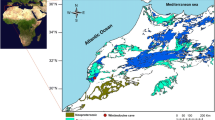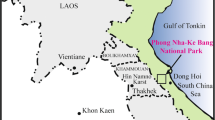Abstract
Understanding of hydrological processes in caves is important to help us interpret paleoclimate records from speleothems. In this study, we integrated hydrogeological and hydrogeochemical properties to characterize the hydraulic behavior of karst waters in the Heshang Cave, Central China. Using geological and topographical analyses, we identified regional watershed boundaries and hydrogeological connections that were controlled by anticlinal geometry and faults. Water samples were collected from the Heshang Cave and potential recharge sites. Geochemical data of c(Sr2+)/c(Ca2+) and c(Mg2+)/c(Ca2+) ratios suggest that the drainage system in Heshang Cave consists of two flow paths. For vadose waters, including drip water and rimstone pool water, c(Sr2+)/c(Ca2+) ratio ranges from 0.000 6 to 0.001 1, and c(Mg2+)/c(Ca2+) ratio ranges from 0.97 to 1.1, indicating that recharge was mainly from rainfall infiltration through the overlying Cambrian dolomite stratum. In contrast, slope current and underground river waters have higher c(Sr2+)/c(Ca2+) ratios (values from 0.002 2 to 0.002 8), and lower c(Mg2+)/c(Ca2+) ratios (values from 0.50 to 0.64). These waters show homogeneous isotopic composition (δ18O: −7.15‰–−6.95‰; δD: −52.73‰–−51.31‰), implying recharge of allogeneic water from the Xiaoer River via karst conduits that pass through Ordovician limestone and Cambrian dolomite stratum.
Similar content being viewed by others
References Cited
Bakalowicz, M., 2005. Karst Groundwater: A Challenge for New Resources. Hydrogeology Journal, 13(1): 148–160
Bakers, A., Brunsdon, C., 2003. Non-Linearities in Drip Water Hydrology: An Example from Stump Cross Caverns, Yorkshire. Journal of Hydrology, 277(3–4): 151–163
Baldini, J. U. L., McDermott, F., Fairchild, I. J., 2006. Spatial Variability in Cave Drip Water Hydrochemistry: Implications for Stalagmite Paleoclimate Records. Chemical Geology, 235(3–4): 390–404
Barbieri, M., Boschetti, T., Petitta, M., et al., 2005. Stable Isotope (2H, 18O and 87Sr/86Sr) and Hydrochemistry Monitoring for Groundwater Hydrodynamics Analysis in a Karst Aquifer (Gran Sasso, Central Italy). Applied Geochemistry, 20(11): 2063–2081
Fairchild, I. J., Borsato, A., Tooth, A. F., et al., 2000. Controls on Trace Element (Sr-Mg) Compositions of Carbonate Cave Waters: Implications for Speleothem Climatic Records. Chemical Geology, 166(3–4): 255–269
Fairchild, I. J., Tuckwell, G. W., Baker, A., et al., 2006. Modelling of Dripwater Hydrology and Hydrogeochemistry in a Weakly Karstified Aquifer (Bath, UK): Implications for Climate Change Studies. Journal of Hydrology, 321(1–4): 213–231
Genty, D., Deflandre, G., 1998. Drip Flow Variations under a Stalactite of the Pere Noel Cave (Belgium). Evidence of Seasonal Variations and Air Pressure Constraints. Journal of Hydrology, 211(1–4): 208–232
Han, G. L., Liu, C. Q., 2004. Water Geochemistry Controlled by Carbonate Dissolution: A Study of the River Waters Draining Karst-Dominated Terrain, Guizhou Province, China. Chemical Geology, 204(1–2): 1–21
Hu, C. Y., Henderson, G. M., Huang, J. H., et al., 2008a. Report of a Three-Year Monitoring Programme at Heshang Cave, Central China. International Journal of Speleology, 37(3): 143–151
Hu, C. Y., Henderson, G. M., Huang, J. H., et al., 2008b. Quantification of Holocene Asian Monsoon Rainfall from Spatially Separated Cave Records. Earth and Planetary Science Letters, 266(3–4): 221–232
Hu, C. Y., Huang, J. H., Fang, N. Q., et al., 2005. Adsorbed Silica in Stalagmite Carbonate and Its Relationship to Past Rainfall. Geochimica et Cosmochimica Acta, 69(9): 2285–2292
Johnson, K. R., Hu, C. Y., Belshaw, N. S., et al., 2006. Seasonal Trace-Element and Stable-Isotope Variations in a Chinese Speleothem: The Potential for High-Resolution Paleomonsoon Reconstruction. Earth and Planetary Science Letters, 244(1–2): 394–407
Karst Research Group, 1978. Karst Research of China. Science Press, Beijing (in Chinese)
Kattan, Z., 2001. Use of Hydrochemistry and Environmental Isotopes for Evaluation of Groundwater in the Paleogene Limestone Aquifer of the Ras Al-Ain Area (Syrian Jezireh). Environmental Geology, 41(1–2): 128–144
Katz, B. G., Bullen, T. D., 1996. The Combined Use of Sr-87/Sr-86 and Carbon and Water Isotopes to Study the Hydrochemical Interaction between Groundwater and Lakewater in Mantled Karst. Geochimica et Cosmochimica Acta, 60(24): 5075–5087
Li, B., Yuan, D. X., Qin, J. M., et al., 2000. Oxygen and Carbon Isotopic Characteristics of Rainwater, Drip Water and Present Speleothems in a Cave in Guilin Area, and Their Environmental Meanings. Science in China Series D: Earth Sciences, 43(3): 277–285
Ma, T., Wang, Y. X., Guo, Q. H., et al., 2009. Hydrochemical and Isotopic Evidence of Origin of Thermal Karst Water at Taiyuan, Northern China. Journal of Earth Science, 20(5): 879–889
Marfia, A. M., Krishnamurthy, R. V., Atekwana, E. A., et al., 2004. Isotopic and Geochemical Evolution of Ground and Surface Waters in a Karst Dominated Geological Setting: A Case Study from Belize, Central America. Applied Geochemistry, 19(6): 937–946
McDonald, J., Drysdale, R., Hill, D., 2004. The 2002–2003 El Nino Recorded in Australian Cave Drip Waters: Implications for Reconstructing Rainfall Histories Using Stalagmites. Geophysical Research Letters, 31(22): L22202
Partin, J. W., Cobb, K. M., Adkins, J. F., et al., 2013. Trace Metal and Carbon Isotopic Variations in Cave Dripwater and Stalagmite Geochemistry from Northern Borneo. Geochemistry, Geophysics, Geosystems, 14(9): 3567–3585
Perez, J. J., Sanz, E., 2011. Hydrodynamic Characteristics and Sustainable Use of a Karst Aquifer of High Environmental Value in the Cabrejas Range (Soria, Spain). Environmental Earth Sciences, 62(3): 467–479
Pu, J. B., Yuan, D. X., Zhang, C., et al., 2012. Tracing the Sources of Strontium in Karst Groundwater in Chongqing, China: A Combined Hydrogeochemical Approach and Strontium Isotope. Environmental Earth Sciences, 67(8): 2371–2381
Ravbar, N., Barbera, J. A., Petric, M., et al., 2012. The Study of Hydrodynamic Behaviour of a Complex Karst System under Low-Flow Conditions Using Natural and Artificial Tracers (the Catchment of the Unica River, SW Slovenia). Environmental Earth Sciences, 65(8): 2259–2272
Ruan, J. Y., Hu, C. Y., 2010. Seasonal Variations and Environmental Controls on Stalagmite Calcite Crystal Growth in Heshang Cave, Central China. Chinese Science Bulletin, 55(34): 3929–3935
Wan, J. W., Shen, J. F., Chao, N., 1997. The Characteristics of Karst Cave Development and Tourism Resources in Banxia Area of the Qingjiang River. Carsologica Sinica, 16(3): 268–278 (in Chinese with English Abstract)
Wu, P., Tang, C. Y., Zhu, L. J., et al., 2009. Hydrogeochemical Characteristics of Surface Water and Groundwater in the Karst Basin, Southwest China. Hydrological Processes, 23(14): 2012–2022
Yamada, M., Ohsawa, S., Matsuoka, H., et al., 2008. Derivation of Travel Time of Limestone Cave Drip Water Using Tritium/Helium 3 Dating Method. Geophysical Research Letters, 35(8): L08405
Zhao, J. C., Wei, B. H., Xiao, S. B., 2009. Stable Isotopic Characteristics of Atmospheric Precipitation from Yichang, Hubei. Tropical Geography, 29(6): 526–531 (in Chinese with English Abstract)
Author information
Authors and Affiliations
Corresponding author
Rights and permissions
About this article
Cite this article
Long, X., Sun, Z., Zhou, A. et al. Hydrogeochemical and isotopic evidence for flow paths of karst waters collected in the Heshang Cave, Central China. J. Earth Sci. 26, 149–156 (2015). https://doi.org/10.1007/s12583-015-0522-2
Received:
Accepted:
Published:
Issue Date:
DOI: https://doi.org/10.1007/s12583-015-0522-2




